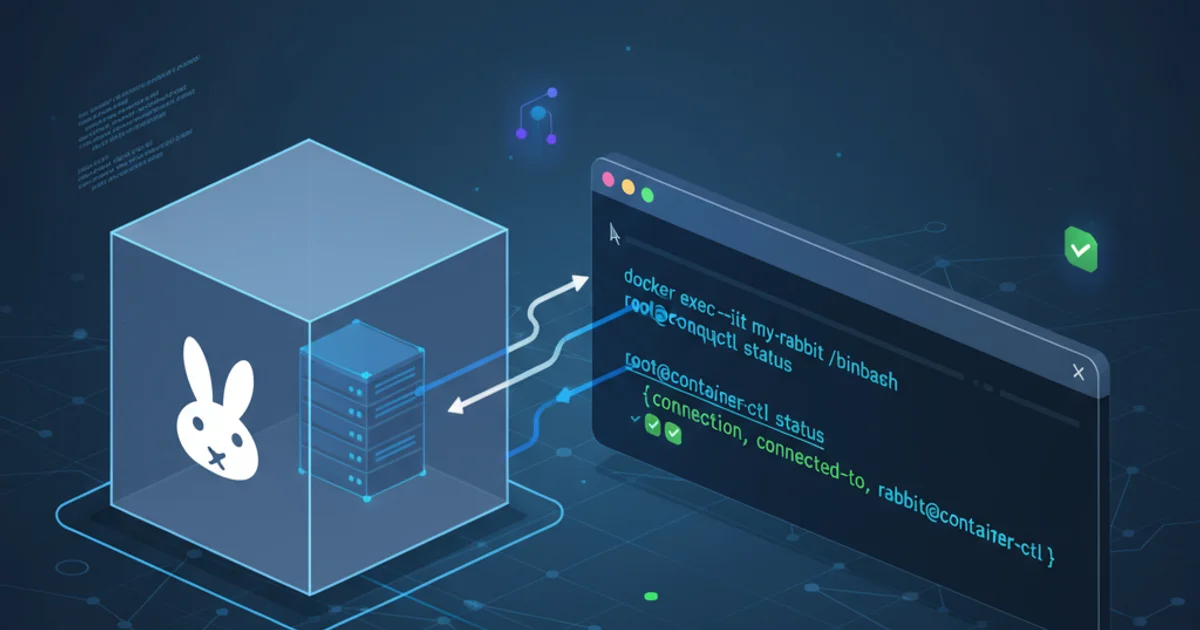How to use rabbitmqctl to connect to the rabbitmqserver in the docker container?
Categories:
Connecting to RabbitMQ in Docker with rabbitmqctl

Learn how to effectively use rabbitmqctl to manage your RabbitMQ server running inside a Docker container, covering common commands and troubleshooting tips.
Running RabbitMQ in a Docker container is a common practice for development, testing, and even production environments due to its portability and ease of deployment. However, interacting with the RabbitMQ server using its administrative tool, rabbitmqctl, can be a bit different when it's encapsulated within a container. This article will guide you through the process of connecting to your RabbitMQ instance inside Docker and executing rabbitmqctl commands.
Understanding the Challenge
When RabbitMQ runs in a Docker container, rabbitmqctl is typically installed within that same container. This means you cannot simply run rabbitmqctl directly from your host machine's terminal. Instead, you need to execute the command inside the running container. Docker provides mechanisms to do this, primarily through the docker exec command.
flowchart TD
A[Host Machine] --> B{Docker Daemon}
B --> C[RabbitMQ Container]
C --> D["rabbitmqctl (inside container)"]
A -- "docker exec" --> D
D -- "Admin Commands" --> E[RabbitMQ Server]
E -- "Status/Output" --> DInteraction flow for rabbitmqctl with a Dockerized RabbitMQ
Prerequisites
Before you begin, ensure you have the following:
- Docker Installed: You need Docker Engine running on your host machine.
- RabbitMQ Container Running: A RabbitMQ Docker container should be up and running. If you don't have one, you can start a basic one using
docker run -d --hostname my-rabbit --name some-rabbit -p 5672:5672 -p 15672:15672 rabbitmq:3-management.
-p 15672:15672 flag in the docker run command exposes the management plugin's web interface, which is very useful for monitoring and basic administration. The -p 5672:5672 exposes the AMQP port for client connections.Executing rabbitmqctl Commands
The primary method to run rabbitmqctl commands is using docker exec. This command allows you to execute a command in a running container. The basic syntax is docker exec [OPTIONS] CONTAINER COMMAND [ARG...].
docker exec some-rabbit rabbitmqctl status
Checking the status of the RabbitMQ server
In this command:
docker exec: The Docker command to execute a process in a running container.some-rabbit: The name of your RabbitMQ container. Replace this with the actual name or ID of your container.rabbitmqctl status: The actualrabbitmqctlcommand you want to run.
Common rabbitmqctl Commands in Docker
Here are some frequently used rabbitmqctl commands and how to execute them within your Docker container.
# List all queues
docker exec some-rabbit rabbitmqctl list_queues
# List all exchanges
docker exec some-rabbit rabbitmqctl list_exchanges
# List all users
docker exec some-rabbit rabbitmqctl list_users
# Add a new user (replace 'myuser' and 'mypassword')
docker exec some-rabbit rabbitmqctl add_user myuser mypassword
# Set permissions for a user
docker exec some-rabbit rabbitmqctl set_permissions -p / myuser ".*" ".*" ".*"
# Delete a user
docker exec some-rabbit rabbitmqctl delete_user myuser
# Stop the RabbitMQ application (without stopping the container)
docker exec some-rabbit rabbitmqctl stop_app
# Start the RabbitMQ application
docker exec some-rabbit rabbitmqctl start_app
Examples of common rabbitmqctl commands
Interactive Shell Access
Sometimes, you might want to enter an interactive shell inside the RabbitMQ container to run multiple rabbitmqctl commands or inspect the container's file system. You can do this using docker exec -it.
docker exec -it some-rabbit bash
Accessing an interactive bash shell inside the container
Once inside the container's shell, you can run rabbitmqctl commands directly without the docker exec prefix:
rabbitmqctl status
rabbitmqctl list_queues
exit # To exit the container shell
bash installed. In such cases, try sh instead: docker exec -it some-rabbit sh.Troubleshooting Common Issues
If you encounter issues, consider the following:
- Container Not Running: Ensure your RabbitMQ container is actually running using
docker ps. - Incorrect Container Name/ID: Double-check the container name or ID you are using with
docker ps. rabbitmqctlNot Found: This usually means you're trying to runrabbitmqctlon the host machine instead of inside the container, or the container image is highly stripped down and doesn't include it (which is rare for official RabbitMQ images).- Permissions Issues: If you're trying to modify configurations or users, ensure the RabbitMQ application is running and you have the necessary administrative privileges (which
rabbitmqctltypically handles by default when executed inside the container).
1. Verify Container Status
Run docker ps to confirm your RabbitMQ container is running and note its name or ID.
2. Execute a Simple Command
Try a basic command like docker exec <container_name_or_id> rabbitmqctl status to ensure connectivity.
3. Check Container Logs
If rabbitmqctl commands fail, check the container logs for errors: docker logs <container_name_or_id>.